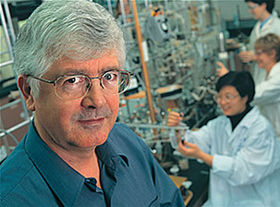Lab Snapshot

Introducing the Longstaffe Lab
 Established in 1987, Dr. Fred Longstaffe’s laboratory has become a leading research facility for the study of stable isotopes in Canada. Supported by grants from the Natural Sciences and Engineering Research Council, Social Science and Humanities Research Council and Canada Foundation for Innovation, the laboratory’s main focus is environmental chemistry and climate reconstructions of past environments. Recent advancement, however, have allowed the laboratory to expand into new research areas including the investigation of anthropological materials to examine past diet and agricultural practices, as well as the investigation of meteoritic material to better understand the building blocks of our solar system.
Established in 1987, Dr. Fred Longstaffe’s laboratory has become a leading research facility for the study of stable isotopes in Canada. Supported by grants from the Natural Sciences and Engineering Research Council, Social Science and Humanities Research Council and Canada Foundation for Innovation, the laboratory’s main focus is environmental chemistry and climate reconstructions of past environments. Recent advancement, however, have allowed the laboratory to expand into new research areas including the investigation of anthropological materials to examine past diet and agricultural practices, as well as the investigation of meteoritic material to better understand the building blocks of our solar system.
This wide breath of research, carried out by more than 20 graduate students, is made possible by the state-of-the-art equipment that is available at the Laboratory of Stable Isotope Science (LSIS). Here, the blossoming scholars have access to high precision mass spectrometers, laser systems, and elemental analyzers allowing them to conduct the research about which they are truly passionate. Recent graduate, Dr. Rachel Schwartz-Narboone’s study, is a prime example of the innovative research being carried out by Longstaffe’s group. As a PhD candidate, Rachael examined the bones of woolly mammoths and compared their chemical isotopes or fingerprints to current and past occurrences of plants to prove that the prehistoric beasts were actually herbivores. Up to this point, isotope studies had shown that mammoths were carnivores. The game-changing proof was published in Nature, and provided Schwartz-Narboone with the additional opportunity to share her findings via a national broadcast network in Canada.
 Longstaffe received a BSc in geology from the University of Windsor in 1978 and PhD from McMaster University in 1978. He was appointed as Western’s Provost and Vice-President (Academic) for a five-year term on July 1, 2005 after being Dean of Science from 1999 to 2005. In addition, he has been an active member of Senate and Board of Governors.
Longstaffe received a BSc in geology from the University of Windsor in 1978 and PhD from McMaster University in 1978. He was appointed as Western’s Provost and Vice-President (Academic) for a five-year term on July 1, 2005 after being Dean of Science from 1999 to 2005. In addition, he has been an active member of Senate and Board of Governors.
Teaching and developing capacity in the next generation of researchers has always remained important to Longstaffe as is illustrated in his frequent appearance on the USC Teaching Honor Roll and as the 2005 recipient of the E.G. Pleva Teaching Award.

 Established in 1987, Dr. Fred Longstaffe’s laboratory has become a leading research facility for the study of stable isotopes in Canada. Supported by grants from the Natural Sciences and Engineering Research Council, Social Science and Humanities Research Council and Canada Foundation for Innovation, the laboratory’s main focus
Established in 1987, Dr. Fred Longstaffe’s laboratory has become a leading research facility for the study of stable isotopes in Canada. Supported by grants from the Natural Sciences and Engineering Research Council, Social Science and Humanities Research Council and Canada Foundation for Innovation, the laboratory’s main focus  Longstaffe received a BSc in geology from the University of Windsor in 1978 and
Longstaffe received a BSc in geology from the University of Windsor in 1978 and 
